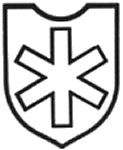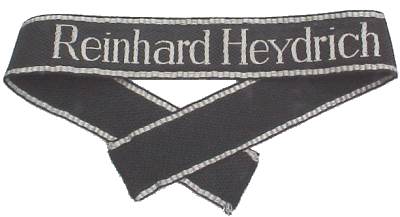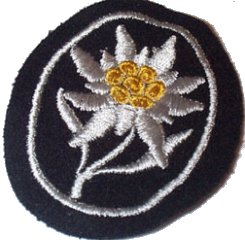
When Norway capitulated in June 1940, there were still some armed Norwegian forces intact: two Infantry Battalions and one Motorised Artillery Battery which guarded the Norwegian/Soviet-Russian and Finnish border in East-Finnmark. These units were led by Colonel Wilhelm Faye.
As Hitler did not want to deploy ordinary Heer units to replace the Norwegians, the choice was SS-Totenkopf-Standarte 9 led by SS-Obersturmbannführer Ernst Deutsch. However, the first unit to arrive in Kirkenes, was called “SS Batallion Reitz”, named after their commander SS-Obersturmbannführer Wilhelm Reitz.
During the spring 1941, two new Standarten (Regiments) arrived: the 6th and 7th. After a short time, the 6th SS, with large elements from the 9th SS, moved into positions at Salla in Northern-Finland. General von Falkenhorst did, however, not trust their fighting ability very much, because even If the formations were well equipped, the men were poorly trained. The two latter regiments crossed the Finnish/Norwegian border, and were ready at Salla the 22nd June, 1941.
As the attack on Soviet came, the divisions, now usually called “Brigades”, were thrown into the battle at Markajärvi-Salla. They suffered great losses, and were an expected disappointment to the German commanders: Falkenhorst and Buschenhagen. The SS forces lost 700 men the first two days in combat with strong Russian forces (300 KIA and 400 WIA).
The Brigade got a new unit attached, SS-Gebirgsartillerie-Regiment 6, and was now redesigned as a Division. During the autumn 1941, the Division was handed over to the battle-hardened Finnish General Hjalmar Siilasvuo (this was the only time that an SS Division was commanded by a foreign officer), and took positions at Louchi/Kiestinki. Gen. Siilasvuo was no bad choice for an Army Corps commander: he had served in the Finnish famous volunteer “Jägerbatallion 27” during WW 1, on the German side.
A Führer order was soon to be given, which said “…As for the SS-units, there is to be formed a new SS-Gebirgsbrigade formed by volunteering Norwegians and Finns. An Austrian SS-regiment is to be attached, and the remaining units are to be deployed from “Kampfgruppe Nord“.
A unit by Finnish volunteers was never formed in this case, but a Norwegian one soon came true: the Freiwilligen-Schikompanie “Norwegen”, later Frw-Skibatallion “Norwegen” (Norwegian: “Skijegerbataljonen”).
It was formed in February 1941 in Norway as “SS-Kampfgruppe Nord” by “Stab des Befehlshaber der Waffen-SS in Norwegen”.
From September 1941 the unit was officially designated “SS-Division Nord”. In January it was converted to a “SS-Gebirgs-Division”, and new units began forming in Germany for the division. These arrived in September 1942, and the division was redesigned “SS-Gebirgs-Division Nord”.
In October it got a divisional number, and was finally redesignated “6. SS-Gebirgs-Division Nord”.
It fought in Karelia until the Finnish armistice in September 1944 when it marched on foot 1.600km through Finland and Norway. It arrived in Denmark in December and transferred to the Palatinate in western Germany . It fought in the Nordwind offensive in January 1945 were it suffered heavy losses.
SS-Gruppenführer Karl Brenner on the replacements recieved after the heavy losses in early 1945 and their effect on Nord:Numerically, those losses had been more or less compensated by assignment of new replacements. These consisted for the greater part of young Volksdeutsche who had recieved only a brief training and had not volunteered, but been drafted to the Waffen-SS in the normal conscription procedure. Their fighting value was therefore correspondingly lower then had been the case with the former personnel and naturally lowered the combat efficieny of the entire division. (1)
It was used for static defence near Bitche in February and was transferred to the Saar in March where it was destroyed as a unit though survivors fought on with elements from 38. SS-Grenadier-Division Nibelungen.
Known war crimes
During the retreat from Finland to Norway (Unternehmen Birke) the division destroyed the Finnish town of Rovaniemi. In recent years there have however been suggestions that the destruction was caused by a Finnish attack on a German ammunition train parked at the station in Rovaniemi that set off a large explosion rather than any actions on part of the Nord division.
Lineage
SS-Kampfgruppe Nord (Feb 1941 – Sep 1941)
SS-Division Nord (Sep 1941 – Sep 1942)
SS-Gebirgs-Division Nord (Sep 1942 – Oct 1943)
6. SS-Gebirgs-Division Nord (Oct 1943 – May 1945)
Commanders
SS-Brigadeführer Karl Herrmann (28 Feb 1941 – 15 May 1941)
SS-Obergruppenführer Karl-Maria Demelhuber (15 May 1941 – 1 Apr 1942)
SS-Obergruppenführer Matthias Kleinheisterkamp (1 Apr 1942 – 20 Apr 1942)
SS-Oberführer Hans Scheider (20 Apr 1942 – 14 June 1942)
SS-Obergruppenführer Matthias Kleinheisterkamp (14 June 1942 – 15 Jan 1943)
SS-Gruppenführer Lothar Debes (15 Jan 1943 – 14 June 1944)
SS-Obergruppenführer Friedrich-Wilhelm Krüger (14 June 1944 – 23 Aug 1944)
SS-Brigadeführer Gustav Lombard (23 Aug 1944 – 1 Sep 1944)
SS-Gruppenführer Karl Brenner (1 Sep 1944 – 3 Apr 1945)
SS-Standartenführer Franz Schreiber (3 Apr 1945 – 8 May 1945)
Chief of Staff
SS-Hauptsturmführer Joachim Ruoff (5 Apr 1941 – ? June 1941)
SS-Obersturmbannführer Paul Geiser (21 June 1941 – 1 Aug 1941)
SS-Sturmbannführer Joachim Ruoff (9 Aug 1941 – ? Apr 1942)
SS-Sturmbannführer Eugen Kunstmann (? Apr 1942 – ? Oct 1942)
SS-Sturmbannführer Heinz Küchle (? Oct 1942 – 18 Sep 1944)
Major Bernhard-Siegfried Sander (? Sep 1944 – ? Feb 1945)
SS-Haupsturmführer Georg Berger (1 Mar 1945 – ? 1945)
Quartermaster
SS-Hauptsturmführer Heinz Küchle (? 1941 – ? Oct 1942)
SS-Sturmbannführer Baumann (? Jan 1943 – ? Dec 1943)
SS-Hauptsturmführer Dr. Wener Sander (1 July 1944 – 1 Mar 1945)
Area of operations
Germany (Feb 1941 – June 1941)
Finland & northern Russia (June 1941 – Nov 1944)
Norway & Denmark (Nov 1944 – Jan 1945)
Western Germany (Jan 1945 – Apr 1945)
Austria (Apr 1945 – May 1945)
Manpower strength
June 1941 10.373
Dec 1942 21.247
Dec 1943 20.129
June 1944 19.355
Dec 1944 15.000
Honor titles
An honor title with a purely geographical meaning; “Nord” simply means “North”. No cufftitle was authorized for the division, but the cufftitle of the Allgemeine-SS Oberabschnitt “Nord” was used by some individuals.
Two regiments of this division were also named:
SS-Gebirgsjäger-Rgt. 11 „Reinhard Heydrich“
The regiment was named after one of the most infamous and ruthless SS leaders, SS-Obergruppenführer Reinhard Heydrich (7 March 1904 – 4 June 1942) after his death. A dismissed former naval officer, Heydrich was the founder and head of the Sicherheitsdienst or SD (the SS’ security service) and, from 1939, the head of the Reichssicherheitshauptamt or RSHA, (the Reich Security Main Office) to which, apart from the SD, both the Gestapo and the Criminal Police were subordinated. One of the Holocaust’s main “architects”, he furthermore became acting Reichsprotektor for Bohemia and Moravia in addition to his continued appointment as chief of the RSHA in September 1941 and it has here that he gained his epithet as the “Butcher of Prague”. Heydrich died from an infection due to wounds suffered in an assassination attempt undertaken by British-trained and –equipped agents of the Czech exile government. As retaliation for his death, large-scale acts of violence and terror against the Czech population were undertaken, including the complete destruction of the town of Lidice.
SS-Gebirgsjäger-Rgt. 12 „Michael Gaißmair“
Michael Gaißmair (ca. 1490 – 1532), a toll collector from Brixen in Tyrol, lived in the same era as Florian Geyer, Götz von Berlichingen and Georg von Frundsberg. (see 8th, 10th and 17th divisions) A radical Protestant, he led an unsuccessful peasant rebellion against the Habsburg Monarchy. Having fled to Italy, where he tried to stir up a new rebellion, he was eventually assassinated in Padua by Habsburg agents.
Holders of high awards
Holders of the Close Combat Clasp in Gold (2)
– Bucher, Maximilian, 00.12.1944, SS-Hauptscharführer, Zugführer i. d. 3./SS-Schtz.Btl. 6
– Ottmann, Werner, 00.04.1945, SS-Hauptsturmführer, Kdr. SS-Pz.Gren.Btl. 506
Holders of the German Cross in Gold (17)
Holders of the German Cross in Silver (1)
– Sander, Dr. Werner, 30.12.1944, SS-Hauptsturmführer d.R., Ib 6. SS-Geb.Div. “Nord”
Holders of the Honor Roll Clasp of the Heer (9)
– Bucher, Maximilian, 15.08.1944, SS-Hauptscharführer, 3./SS-Schtz.Btl. (mot) 6
– Degen, Günther, 25.10.1944, SS-Hauptsturmführer, I./SS-Geb.Jäg.Rgt. 11 “Reinhard Heydrich”
– Fröschle, Walter, 05.03.1945, SS-Unterscharführer d.R., 15./SS-Geb.Jäg.Rgt. 12 “Michael Gaißmair”
– Hasselmann, Willi, 07.06.1943, SS-Obersturmführer, 2./Aufkl.Abt./SS-Geb.Div. Nord
– Lorenz, Heinrich, 17.09.1943, SS-Unterscharführer, 2./SS-Pz.Jäg.Abt. Nord
– Pauker, Hans, 25.03.1944, SS-Untersturmführer, 4./SS-Geb.Jäg.Rgt. 12
– Perpeet, Hans, 05.11.1944, SS-Hauptscharführer, 5./SS-Geb.Jäg.Rgt. 11 “Reinhard Heydrich”
– Rädeke, Ernst, 07.01.1945, SS-Sturmbannführer, SS-Geb.Jäg.Rgt. 11 “Reinhard Heydrich”
– Schuhmann, Paul, 17.08.1944, SS-Hauptscharführer, 3./SS-Schtz.Btl. (mot) 6
Holders of the Knight’s Cross (6)
– Bauer, Hans 05.04.1945 SS-Obersturmführer Führer 3./SS-Pz.Gren.Btl 506 [Kgr Bauer] [attached to 416. Inf.Div in feb 1945 ; Westwall defense area Hamm/Saarschleife]
– Brenner, Karl-Heinrich 27.12.1944 SS-Gruppenführer und Generalleutnant der Polizei Kdr 6. SS-Geb.Div „Nord“
– Degen, Günther 07.10.1944 SS-Hauptsturmführer Führer I./SS-Geb.Jäg.Rgt 11 „Reinhard Heydrich“
– Krüger, Friedrich-Wilhelm 22.10.1944 SS-Obergruppenführer und General der Waffen-SS und Polizei Kdr 6. SS-Geb.Div „Nord“
– Renz, Gottlieb 12.08.1944 SS-Hauptsturmführer d.R. Kdr SS-Schtz.Btl 6
– Schreiber, Franz 26.12.1944 SS-Standartenführer Kdr SS-Geb.Jäg.Rgt 12 „Michael Gaißmair“
Holders of the Finnish Order of the Cross of Liberty, 1st Class with Swords (2)
– Demelhuber, Karl-Maria, 01.12.1941, SS-Brigadeführer und Generalmajor der Waffen-SS, Kdr. SS-Div. “Nord”
– Kleinheisterkamp, Matthias, 13.05.1943, SS-Brigadeführer und Generalmajor der Waffen-SS, Kdr. SS-Geb.Div. “Nord”
Order of battle (1941)
Stab
SS-Infanterie-Regiment 6
SS-Infanterie-Regiment 7
SS-Infanterie-Regiment 9
Artillerie-Regiment
SS-Werfer-Abteilung
Sturmgeschütz-Abteilung
Nachrichten-Abteilung
Pionier-Bataillon
Panzerjäger-Abteilung
Aufklärungs-Abteilung
Werkstatt-Kompanie (mot)
Order of battle
Stab der Division
SS-Gebirgsjäger Regiment 11 Reinhard Heydrich
SS-Gebirgsjäger Regiment 12 Michael Gaissmair
SS-Polizei-Grenadier-Bataillon (mot) 506 (formed from the SS Skijegerbataljon Norge after the arrival in Oslo)
SS-Gebirgs Artillerie Regiment 6
SS-Sturmgeschütz Batterie 6
SS-Schützen-Abteilung (mot) 6
SS-Gebirgs-Panzerjäger-Abteilung 6
SS-Flak-Abteilung 6
SS-Gebirgs-Nachrichten-Abteilung (mot) 6
SS-Gebirgs-Aufklärungs-Abteilung (mot) 6
SS-Gebirgs-Pionier-Abteilung 6
SS-Dina 6
SS-Bekleidungs-Instandsetzungs-Kompanie 6
SS-Sanitäts-Kompanie 6
SS-Veterinär-Kompanie 6
SS-Kriegsberichter-Zug 6
SS-Feldgendarmerie-Trupp 6
2. Politikompani (consisted of Norwegian volunteers, subordinated to AA6 for short periods)
3. SS- og Politikompani (consisted of Norwegian volunteers, replaced 3./Skijegerbataljon June 1944)
Notable members
Rudolf von Ribbentrop (son of the Foreign Minister Joachim Von Ribbentrop)
Officers serving in the Einsatzgruppen and Concentration Camps
Concentration Camps 57
(includes officers serving in the Einsatzgruppen or Concentration Camps either prior to or after service in this unit)
Insignia
The “Reinhard Heydrich” cuff title was authorized for SS-Gebirgsjäger Regiment 11 Reinhard Heydrich 15 June 1942.

Courtesy of Ruptured Duck)
The “Michael Gaißmair” cuff title was authorized for SS-Gebirgsjäger Regiment 12 Michael Gaißmair 15 June 1942.
No “Nord” cuff title was issued but is know to have been used unofficially.
Waffen-SS Gebirgsjäger Sleeve Badge

(Courtesy of The Ruptured Duck)
In fiction
The 2002 Russian movie “The Cuckoo” (“Kukushka) directed by Aleksandr Rogozhkin features soldiers from the Nord division.
Soldiers from the Nord division play a large part in the 2007 vampire comic “30 Days of Night: Red Snow” by Ben templesmith.
Footnotes
1. “Valhalla’s Warriors: A history of the Waffen-SS on the Eastern Front 1941-1945” by Terry Goldsworthy, page 52. The term “foreign nationals of German descent” in the original was replaced by “Volksdeutsche” to be in-line with the normal terminology.
Sources used
John R. Angolia – Cloth insignia of the SS
Roger James Bender & Hugh Page Taylor – Uniforms, Organization and History of the Waffen-SS, vol 2
Georges M. Croisier – Waffen-SS (PDF)
Terry Goldsworthy – Valhalla’s Warriors: A history of the Waffen-SS on the Eastern Front 1941-1945
Dr. K-G Klietmann – Die Waffen-SS: eine Dokumentation
James Lucas – Hitler’s Mountain Troops: Fighting at the extremes
Kurt Mehner – Die Waffen-SS und Polizei 1939-1945
Marc J. Rikmenspoel – Waffen-SS Encyclopedia
George H. Stein – The Waffen-SS: Hitler’s Elite Guard at War 1939-1945
Gordon Williamson & Thomas McGuirl – German military cuffbands 1784-present
Gordon Williamson – German Mountain & Ski Troops 1939-45
Gordon Williamson – The Waffen-SS: 6. to 10. Divisions
Mark C. Yerger – Waffen-SS Commanders: The Army, corps and divisional leaders of a legend (2 vol)
Reference material on this unit
Massimiliano Afiero – Nord: La prima divisione da montagna delle Waffen SS
Gerd Knabe – Kamerad Bello: die Geschichte eines Feldhundes
Stephen M. Rusiecki – In Final Defense of the Reich: The Destruction of the 6th SS Mountain Division, Nord
Franz Schreiber – Kampf Unter Dem Nordlicht
Alfred Steurich – Gebirgsjäger im Bild: 6. SS-Gebirgsdivision Nord 1940 – 1945
Johann Voss – Black Edelweiss: A Memoir of Combat and Conscience by a Soldier of the Waffen-SS
Wolf. T. Zoepf – Seven Days in January: With the 6th SS-Mountain Division in Operation Nordwind


